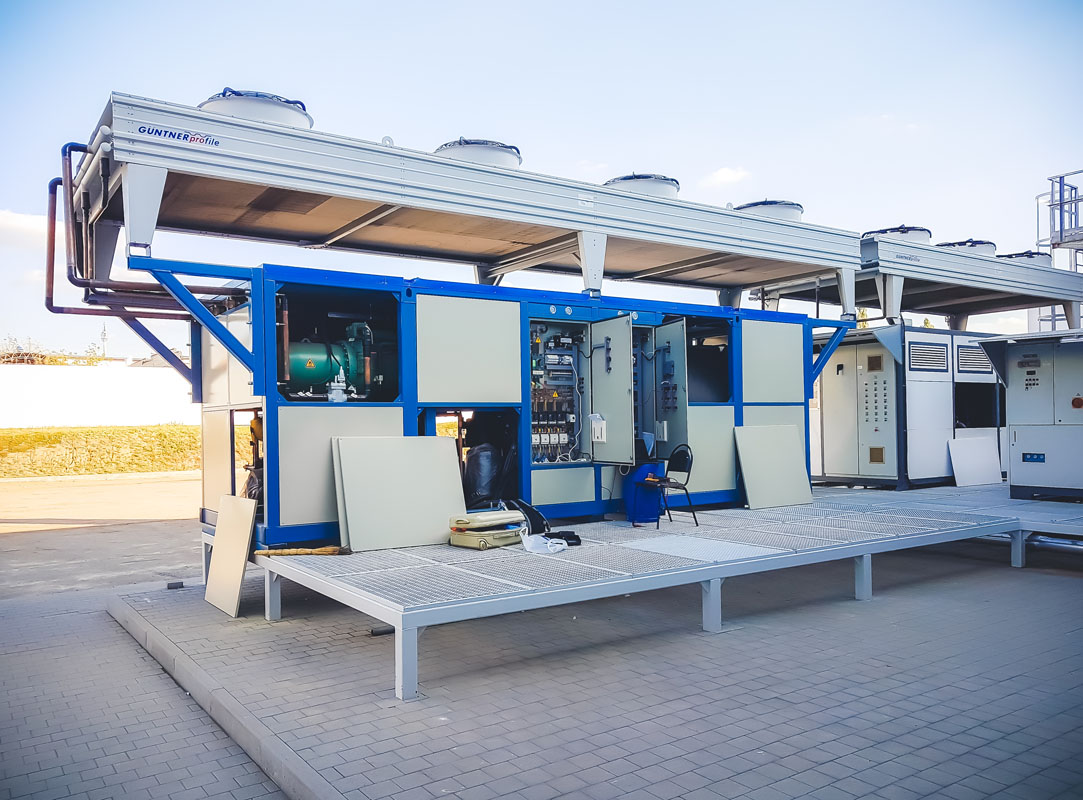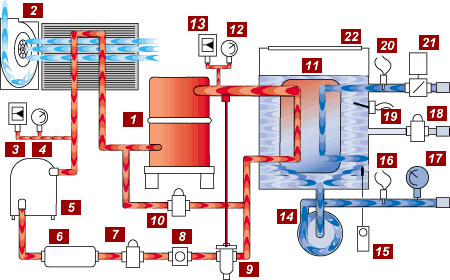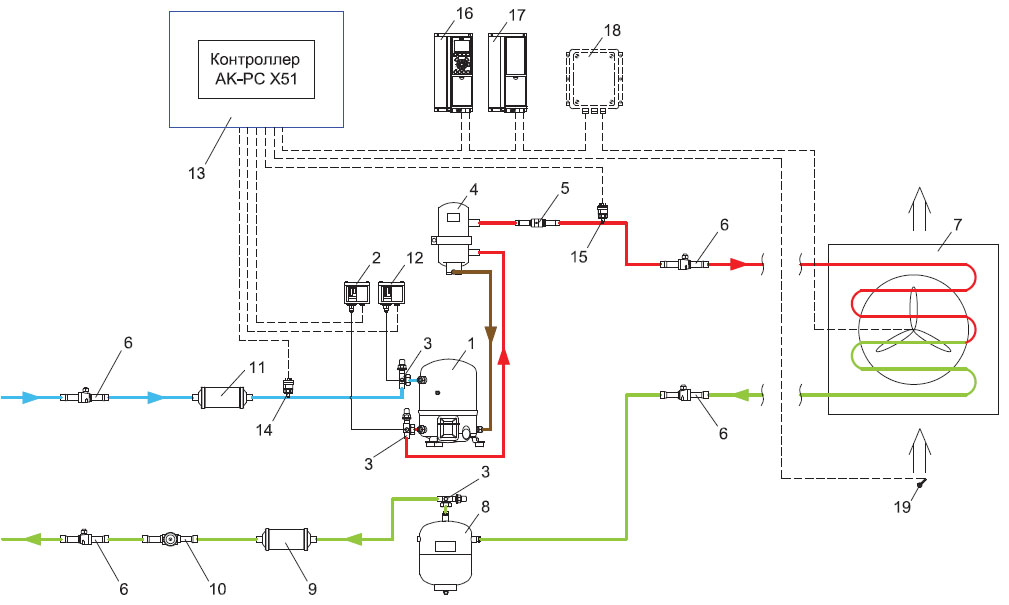Chiller design and operation
What is a chiller? A chiller is a refrigeration unit used for cooling and heating liquid coolants in central air conditioning systems, which may be air handling units or fan coil units. Basically, a chiller for cooling water is used in production - various equipment is cooled. Water has better performance than a glycol mixture, so working on water is more efficient.
A wide power range makes it possible to use the chiller for cooling in rooms of various sizes: from apartments and private houses to offices and hypermarkets. In addition, it is used in the food industry for cooling water and drinks, in the sports and fitness sector - for cooling ice rinks and ice pads, and in pharmaceuticals - for cooling medicines.
The following main types of chillers are:
- monoblock, air condenser, hydraulic module and compressor are in the same housing;
- a chiller with a remote condenser outside (the refrigeration module is located indoors, and the condenser is outside);
- chiller with a water condenser (use when the minimum dimensions of the refrigeration module in the room are needed and there is no possibility to use a remote condenser);
- heat pump, with the possibility of heating or cooling the coolant.

Choosing a chiller is a serious matter that requires a competent solution. Of course, in order to choose a refrigeration unit, you do not need to know all the nuances of the chiller, however, knowledge of the basic principles will help you quickly determine the right model.
How the chiller works
The theoretical basis on which the principle of operation of refrigerators, air conditioners, refrigeration units is based is the second law of thermodynamics. The cooling gas (freon) in refrigeration units performs the so-called reverse Rankine cycle - a kind of reverse Carnot cycle . Moreover, the main heat transfer is based not on compression or expansion of the Carnot cycle, but on phase transitions - evaporation and condensation.
An industrial chiller consists of three main elements: a compressor, a condenser and an evaporator. The main task of the evaporator is to remove heat from the cooled object. To this end, water and refrigerant are passed through it. Boiling, the refrigerant takes energy from the liquid. As a result, water or any other coolant is cooled, and the refrigerant is heated and passes into a gaseous state. After that, the gaseous refrigerant enters the compressor, where it affects the windings of the compressor motor, contributing to their cooling. There, hot steam is compressed, again heating to a temperature of 80-90 C. Here it is mixed with oil from a compressor.
In the heated state, Freon enters the condenser, where the heated refrigerant is cooled by a stream of cold air. Then the final cycle of work begins: the refrigerant from the heat exchanger enters the subcooler, where its temperature decreases, as a result of which the freon goes into a liquid state and is supplied to the filter dryer. There he gets rid of moisture. The next point on the path of movement of the refrigerant is a thermal expansion valve, in which the pressure of freon decreases. After exiting the thermal expander, the refrigerant is low pressure vapor in combination with a liquid. This mixture is fed to the evaporator, where the refrigerant boils again, turning into steam and overheating. Superheated steam leaves the evaporator, which is the beginning of a new cycle.
Industrial chiller operation diagram

# 1 Compressor
The compressor has two functions in the refrigeration cycle. It compresses and moves the refrigerant vapor in the chiller. When vapor is compressed, pressure and temperature increase. Next, the compressed gas enters the air condenser where it cools and turns into a liquid, then the liquid enters the evaporator (while its pressure and temperature decrease), where it boils, goes into a state of gas, thereby taking heat from the water or liquid that passes through the chiller evaporator. After this, the refrigerant vapor flows again to the compressor to repeat the cycle.
# 2 Air-Cooled Condenser
An air-cooled condenser is a heat exchanger where the heat absorbed by the refrigerant is released into the surrounding space. The condenser usually receives compressed gas - freon, which is cooled to the saturation temperature and, condensing, passes into the liquid phase. A centrifugal or axial fan feeds air through the condenser.
# 3 High Pressure Limit
Protects the system from overpressure in the refrigerant circuit.
# 4 High Pressure Pressure Gauge
Provides a visual indication of refrigerant condensation pressure.
# 5 Liquid Receiver
Used to store freon in the system.
# 6 Filter Drier
The filter removes moisture, dirt, and other foreign materials from the refrigerant, which will damage the refrigeration system and reduce efficiency.
# 7 Solenoid valve (Liquid Line Solenoid)
The solenoid valve is simply an electrically operated shut-off valve.
It controls the flow of refrigerant, which closes when the compressor stops. This prevents liquid refrigerant from entering the evaporator, which can cause water hammer. Water hammer can cause serious damage to the compressor. The valve opens when the compressor is on.
# 8 Sight Glass (Refrigerant Sight Glass)
Sight glass helps to observe the flow of liquid refrigerant. Bubbles in the fluid stream indicate a lack of refrigerant. A humidity indicator provides a warning if moisture enters the system, indicating that maintenance is required. The green indicator does not indicate any moisture content. A yellow indicator light indicates that the system is contaminated with moisture and requires maintenance.
# 9 Thermostatic expansion valve (Expansion Valve)
Thermostatic expansion valve
or TRV is a regulator whose position of the regulating body (needle) is determined by the temperature in the evaporator and whose task is to regulate the amount of refrigerant supplied to the evaporator, depending on the overheating of the refrigerant vapor at the outlet of the evaporator. Therefore, at each moment of time, it must supply only such a quantity of refrigerant to the evaporator that, taking into account the current operating conditions, can completely evaporate.
# 10 Hot Gas Bypass Valve
Hot Gas Bypass Valve (capacity regulators) are used to bring the compressor capacity to the actual load on the evaporator (installed in a bypass line between the low and high pressure sides of the cooling system). A hot gas bypass valve (not standard on chillers) prevents short compressor cycling by modulating compressor power. When activated, the valve opens and passes the hot gas of the refrigerant from the discharge into the liquid stream of refrigerant entering the evaporator. This reduces the effective system throughput.
# 11 Evaporator
An evaporator is a device in which a liquid refrigerant boils, absorbing heat during evaporation, from a coolant passing through it.
# 12 Low Pressure Refrigerant Gauge
Provides visual indication of refrigerant vapor pressure.
# 13 Low Refrigerant Pressure Limit
Protects the system from low pressure in the refrigerant circuit so that water does not freeze in the evaporator.
# 14 Coolant Pump
Pump for circulating water in a cooled circuit
# 15 Freezestat Limit
Prevents freezing of liquid in the evaporator
# 16
Temperature sensor
A sensor that displays the temperature of the water in the cooling circuit
# 17 Coolant Pressure Gauge
Provides a visual indication of the coolant pressure supplied to the equipment.
# 18 Automatic Top-Up (Water Make-Up Solenoid)
It turns on when the water in the tank drops below the permissible limit. The solenoid valve opens and is added to the tank from the water supply to the desired level. Then the valve closes.
# 19 Reservoir Level Float Switch
Float switch. Opens when the water level in the tank drops.
# 20 Temperature Sensor 2 (From Process Sensor Probe)
A temperature sensor that displays the temperature of the heated water that is being returned from the equipment.
# 21 Flow switch (Evaporator Flow Switch)
Protects the evaporator from freezing water in it (when the water flow is too low). Protects the pump from dry running. Signals no water flow in the chiller.
# 22 Reservoir
To avoid frequent starts of compressors, an increased capacity is used.
A water-cooled condenser chiller differs from an air-cooled chiller in the type of heat exchanger (instead of a tube-fin heat exchanger with a fan, a shell-and-tube or plate heat exchanger is used, which is cooled by water). Water cooling of the condenser is carried out by circulating water from a dry cooler (dry cooling tower, drycooler) or cooling tower. In order to save water, it is preferable to install a dry cooling tower with a water closed loop. The main advantages of a chiller with a water condenser: compactness; the possibility of internal placement in a small room.
Questions and Answers
Question:
Is it possible to chill liquid to the duct by more than 5 degrees with a chiller?
Answer:
The chiller can be used in a closed system and maintain a given water temperature, for example, 10 degrees, even if the return will be at a temperature of 40 degrees.
There are chillers that cool the water to the duct. It is mainly used for cooling and aerating drinks, soft drinks.
Question:
What is the best chiller or drycooler?
Answer:
The temperature of the refrigerant when using a drycooler depends on the ambient temperature. If, for example, there is +30 on the street, then the coolant will be with a temperature of +35 ... + 40C. Drycooler is used mainly in the cold season to save electricity. The chiller can receive the set temperature at any time of the year. It is possible to manufacture low-temperature chillers to obtain the temperature of a liquid with a negative temperature of minus 70 ° C (the coolant at this temperature is mainly alcohol).
Question:
Which chiller is better - with a water or air condenser?
Answer:
The water-cooled chiller is compact in size, therefore it can be placed indoors and does not generate heat. But cooling the condenser requires cold water.
A chiller with a water condenser has a lower cost, but a dry cooling tower may additionally be required if there is no source of water - a water supply system or well.
Question:
What is the difference between chillers with and without a heat pump?
Answer:
A chiller with a heat pump can work for heating, i.e., not only cool the coolant, but also heat it. It must be borne in mind that with decreasing temperature, heating deteriorates. Heating is most effective when the temperature drops below minus 5.
Question:
How far can I take the air condenser?
Answer:
Typically, the capacitor can be moved up to 15 meters. When installing an oil separation system, a high condenser is possible up to 50 meters, provided that the diameter of the copper pipes between the chiller and the remote condenser is correctly selected.
Question:
To what minimum temperature does the chiller operate?
Answer:
When installing a winter start-up system, the operation of the chiller is possible up to an ambient temperature of minus 30 ...- 40. And when installing Arctic fans - up to minus 55.
Chiller with air-cooled condenser and winter start-up system

Composition - Danfoss compressor
- High pressure switch КР
- Shut-off valve Rotolock
- Differential valve NRD
- KVR condensation pressure regulator
- Air-cooled condenser
- Linear receiver
- Rotolock shut-off valve
- DML filter drier
- Sight glass SG
- EVR solenoid valve
- Coil for Danfoss solenoid valve
- Thermal control valve TE
- Type B soldered evaporator (Danfoss )
- Filter drier DAS / DCR
- Low pressure switch КР
- Shut-off valve Rotolock
- Sensor perature AKS
- fluid flow Relay FQS
- Shield electric
|



